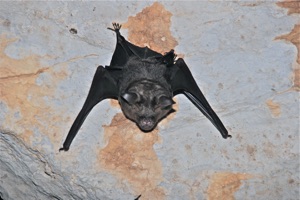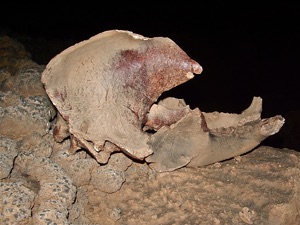Biospeleology of the Nam Dôn system

The underground fauna of the Khoun Dôn - Houay Saï cave
A cave as large as the Houay Saï - Khoun Dôn system offers many opportunities for the development of a diverse and abundant underground fauna.
Insects
So far, the usual crickets, uropyges and scutigera have been observed in various parts of the cave.
Crickets are the preys at the bottom of the food chain.
Uropyges (whip scorpions) are predators that seem to congregate in the hottest galleries, ascending and closed, free from drafts. We believe now that they should be regarded as a “cave is ending here“ signpost. Despite their frightening appearance, they are harmless, a view certainly not shared by the crickets. When they feel threatened, they spray a smelly mist of acetic acid (the vinegar acid) and octanoic (capryllic) acid, both fragrant and aggressive to mucous membranes and eyes.
The scutigera are predators particularly swift and impressive as their length can reach about six inches. Venomous, their bite is probably safe for humans, but we did not bother to take the test.





Crustaceans
Shrimps have been collected in a pool in the Stone River. Crabs were also present, but were not collected.
Amphibians
A few frogs have been found in the Big Loop and in the East Branch, close to the Lake Room. Probably not troglophiles, but their permanence over the years is a source of questions...


Fishes
Numerous cat fishes have been observed all along the river segments found in the cave. These seem to be surface species, trapped into the cave during the dry season. Chela laubuca was collected by J. Lordon in T. Houay Saï in 1998. Troglocyclocheilus khammouanensis, an eyeless cave fish, called “paa kham kong” by the villagers who sometimes catch them in their net during the wet season, was captured in 1998 by Frank Brehier, a french cave diver, and identified later by Maurice Kottelat (1999)
A viper is living in the Tham Khoun Dôn entrance. It can be seen only at dawn, when bats are flying out of the cave, and when cavers are returning to their base camp. Watch your steps, a bite could kill you ! Not kidding !!!



Mammals
Several bat colonies have been located. In Tham Khoun Dôn, the largest permanent colony stays at Bats Junction. Another one was observed in 2011 and 2012 at the beginning of the East Branch, but was absent in 2006. A third colony was observed for the first time in 2012 at the bottom of the boulder slope that gives access to the Khamsone Room from Tham Khoun Dôn. The other two colonies seem to use the Great Fault at the south of the Khamsone Room as main exit route.

Smaller tracks, from rodents or small carnivores are found here and there in the cave.
Even more unusual has been the discovery of a malayan bear skull (Helarctos malayanus) in the Tiger Room, with an associated footprint nearby, preserved on a calcified mud ground.

